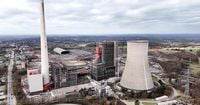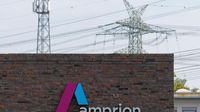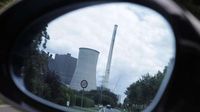In a significant step towards renewable energy, the former Ibbenbüren coal-fired power plant in North Rhine-Westphalia was demolished on April 6, 2025. This demolition marks the transition from coal to wind power, as plans are underway to construct a converter station that will facilitate the integration of offshore wind energy into the electrical grid.
The demolition event began at 11 AM, with the Kesselhaus, a 100-meter-high boiler house, being the first to fall, followed by the cooling tower, which stands at 125 meters. The event was attended by NRW Environment Minister Oliver Krischer, who emphasized the importance of this transition in the context of Germany's energy turnaround.
As part of the safety measures, around 130 residents, including those from a nearby refugee accommodation housing approximately 700 individuals, were evacuated from their homes by 8 AM on the day of the demolition. This precaution ensured that no one would be harmed when the structures were brought down.
The demolition itself was a carefully orchestrated operation, with 500 kilograms of explosives used to bring down the Kesselhaus. In contrast, the cooling tower was not demolished with explosives due to its asbestos-containing supports. Instead, the tower was pulled down using a steel cable technique, which allowed for a controlled collapse.
The Hagedorn Group, which has owned the site since 2023, is responsible for the demolition. The company is preparing the area for Amprion, the transmission grid operator, which plans to construct a converter station on the site. This facility is a key component of the BalWin 2 offshore grid connection project, which aims to connect North Sea wind farms to the mainland grid.
The total cost of the BalWin 2 project is estimated at around 4 billion euros, with the converter station expected to become operational by 2031. The station will convert alternating current generated by offshore wind farms into direct current, which will then be transported via undersea and underground cables to Ibbenbüren. There, it will be converted back into alternating current for distribution through the grid.
Local residents have expressed mixed feelings about the demolition. Gerrit Grunden, a resident living near the plant, noted, "We are happy to see the power plant go, but there is also a sense of nostalgia as it has been a part of our lives for so long." The coal-fired power plant had been a landmark in the Tecklenburger Land for 40 years before its premature closure in 2021 as part of Germany's commitment to reducing carbon emissions.
The demolition was initially scheduled for early March but was postponed for safety reasons, following an incident at another demolition site in Hamburg where a structure unexpectedly remained standing. This led the Hagedorn Group to conduct additional preparatory work, including several test blasts to ensure the safety and effectiveness of the demolition.
In a statement, the city of Ibbenbüren clarified that no tickets were available for spectators wishing to view the demolition. The city asked residents and interested parties to refrain from inquiring about potential viewing points, focusing instead on the safety of those involved.
The demolition of the Ibbenbüren coal-fired power plant represents not just the end of an era but also a pivotal moment in the region's energy landscape. With the transition to renewable energy sources, Ibbenbüren is set to continue its legacy as a site of energy production, albeit in a more sustainable and environmentally friendly manner.
The Hagedorn Group's plans for the site include the completion of the converter station by the summer of 2026, ensuring that the area remains a vital part of Germany's energy infrastructure. This project aligns with the broader goals of the German government to phase out coal and increase reliance on renewable energy sources to combat climate change.
As the dust settles on the site of the former power plant, the community looks forward to a future powered by clean energy, signaling a new chapter in the region's history.









